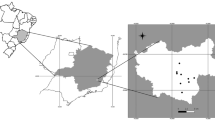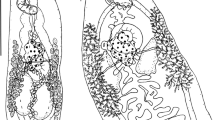Summary
We examined the endoparasites of wild nutria from the native region of South America. Individuals were infected with nineteen species, including Nematoda (82.0 %), Protozoa (46.1 %), Trematoda (33.3 %) and Cestoda (12.8%). Coccidia (Eimeria sp. or Isospora sp.), Strongyloides myopotami and Trichuris myocastoris were the most abundant and prevalent parasites. The diversity of parasite collected on individual hosts ranged from one to four species. There was no significant association between either the age or the sex of the nutria and the prevalence of parasitism, except that the number of infested nutria less than 1 year by Nematoda was significantly higher than in older individuals. Additionally, Cryptosporidium spp. and Giardia spp. were demonstrated in fecal samples, although scarcely. In general, the accessions were found in good bodily condition and carrying low parasite burdens. These numbers appeared insufficient to indicate gastrointestinal parasitism or parasitic disease.
Similar content being viewed by others
References
Acha, P. N., Szyfres, B. (2001): Zoonoses and Communicable Diseases Common to man and animals. 2nd Edition, Pan Americam Health Organization Publishing, Washington, 410 pp.
Allen, A. V., Ridley, D. S. (1970): Further observations on the formolether concentration technique for faecal parasites. J. Clin. Path., 23: 545–546
Babero, B. B., Lee, J. W. (1961): Studies on the helminths of nutria, Myocastor coypus (Molina), in Louisiana with check-list of other worm parasites from this host. J. Parasitol., 47(6): 378–390
Bessonov, A. S., Penkova, R. A., Uspensky, A. V., Shekhotsov, N. V. (1980): Veterinarysanitary examination of nutria (Myocastor coypus) carcasses for Trichinellosis. In: Proceedings of the 5th. International Conference on Trichinellosis, September 1–5. Windsor, U.K., Redbooks Ltd., pp. 423–425
Bollo, E., Pregel, P., Gennero, S., Pizzoni, S., Rosati, S., Nebbia, P., Biolatti, B. (2003): Health status of a population of nutria (Myocastor coypus) living in a protected area in Italy. Res. Vet. Sci., 78(8): 21–25. DOI: 10.1016/S0034-5288(3)000035-3
Bush, O., Lafferty, K. D., Lotz, J. M., Shostack, A. W. (1997): Parasitology meets ecology in its own terms. J. Parasitol. 83: 575–583
Catzeflis, F. M., Hanni, C., Sourrouille, P., Douzery, E. (1995): Molecular systematics of histricograph rodents: evidence from the mitochondrial 12 SrRNA gene. Mol. Phylogenet. Evol., 3: 206–220
Conder, G. B. (1982): Coypus. In: De Beer, G., Bourlière, F. (Eds) Encyclopedia of the animal world. Volume 6. Published by Bay Books Pty Ltd., Sydney, pp. 482–484
Davis, R. A., Shillito, E. (1963): The coypu or nutria (Myocastor coypus Molina). In: UFAW Handbook: Universities Federation For Animal Welfare. Wiley and Blackwell, Oxford, United Kingdom. Chapter 27, pp. 457–467
Dawes, B. (1968): The Trematoda. Cambridge University Press, Cambridge, United Kingdom, 644 pp.
Dunlap, B. G., Thies, M. L. (2002): Giardia in beaver (Castor canadensis) and nutria (Myocastor coypus) from east Texas. J. Parasitol., 88: 1254–1258. DOI: 10.1645/0022-339 (2002)088[1254:GIBC CA]2.0.CO;2
Georgi, J. R. (1974): Parasitology for veterinarians. W.B. Saunders Company, Philadelphia, Pennsylvania, 386 pp.
Gosling, L. M., Baker, S. J., Clarke, C. N. (1988): An attempt to remove coypus (Myocastor coypus) from a wetland habitat in East Anglia. J. Appl. Ecol., 25(4): 49–62
Howerth, E. W., Reeves, A. J., Mcelveen, M., Austin, F. W. (1994): Survey for selected diseases in nutria (Myocastor coypus) from Louisiana. J. Wildlife Dis., 30(3): 450–453
Iucn (2009): Red List of threatened species. International Union fo r the Conservation of Nature. Gland, Switzerland & Cambridge, UK. Retrieved March 13, 2010 from http://www.iucnredlist.org. DOI: 10.111/j.1472-4642.2009. 00633.x
Jokipii, L. S., Pohjola, S., Jokipii, M. M. (1983): Cryptosporidium: a frequent finding in patients with gastrointestinal symptoms. Lancet, 2: 358–361
Kinler, N. W., Linscombe, G., Ramsey, P. R. (1987): Nutria. In: Novak, M., Baker, J., Obbard, M. E., Malloch, B. (Eds) Wild furbearer management and conservation in North America. Ministry of Natural Resources, Ontario, Canada, pp. 327–343
Körner, E. (1985): Krankheiten bei sumpfbibern und deren behandlungsmöglichkeiten. Tierärztl. Prax., 13: 235–240
Lakkonen, J., Soveri, T., Henttonen, H. (1994): Prevalence of Cryptosporidium sp. in peak density Microtus agrestis, Microtus oeconomus and Clethrionomys glareolus populations. J. Wildlife Dis., 30(1): 110–111
Martino, P. E., Stanchi, N. O. (1998): Causes of death in captive nutria (Myocastor coypus) in Argentina. Isr. J. Vet. Med., 53: 83–88
Martino, P. E., Sassaroli, J. C., Calvo, J., Zapata, J., Gimeno, E. (2008): A mortality survey of free range nutria (Myocastor coypus). Eur. J. Wildl. Res., 54: 293–297. http://dx.doi.org/10.1051/vetres:20011141
Menard, A., Agoulon, A., L’hostis, M., Rondelaud, D., Collard, S., Chauvin, A. (2001): Myocastor coypus as a reservoir host of Fasciola hepatica in France. Vet. Res. 32(5): 499–508
Moretti, A., Piergili Fioretti, D., Grelloni, V., Marini, C., Leonardi, L., Velatta, F. (2001): Susceptibility of nutria (Myocastor coypus) to Trichinella infection: biological aspects. Parasite, 8(2): 206–208
Pascal, M., Lorvelec, O., Vigne, J.D., Keith, P., Clergeau, P. (2003): Évolution holocène de la faundes vertébrés de France: invasions et disparitions. Publiée par l’Institut National de la Recherche Agronomique (INRA) et le Centre National de la Recherche Scientifique, París, France, 381 pp.
Pelloté, F., Pascal, M., Lorvelec, O., Clergeau, P. (2008): Les espèces invasives en Bretagne: le Ragondin (Myocastor coypus). Retrieved April 29, 2009 from http://www.bretagne-environnement.org/especes-invasives. DOI: 10.1890/080083
Pridham, T. J., Budd, J., Karstad, H. A. (1966): Common diseases of fur bearing animals. II. Diseases of chinchillas, nutria, and rabbit. Can. Vet. Jour., 7,(4): 84–87
Rübli, H. (1936): Trichinose beim sumpfbiber, Myocastor coypus Mol. Schweizer. Arch. Tierheilk., 78: 420–421
Santos, I. C. (1992): Myocastor coypus as a wild reservoir of Fasciola hepatica. Rev. Brasileira Parasit. Vet., 1(1): 27–30
Scaramella, D., Motti, G. (1988): Allevamento del castorino. 1st Edition, Edagricole Pub., Bologna, Italia, 133 pp.
Scheuring, W. (1990): The examination of intestinal parasitofauna in coypu (Myocastor coypus, Molina 1782) from closed husbandries with particular regard to coccidia. Edited by Akademii Rolcniczej, Wroclaw, Polska, 41 pp.
Soulsby, E. J. (1965): Textbook of veterinary clinical parasitology. Vol. I. Helminths. Blackwell Scientific Publications, Oxford, England, 1120 pp.
Sulaiman, I. M., Fayer, R., Bern, C., Gilman, R. H., Trout, J. M., Schantz, P. M., Das, P., Lal, A. A., Xiao, L. (2003): Triosephosphate isomerase gene characterization and potential zoonotic transmission of Giardia duodenalis. Emerg. Inf. Dis., 9(11): 1444–1452. DOI: 10.3201/eid0911.030084
Verster, A. (1969): A taxonomic revision of the genus Taenia Linnaeus, 1758 st. Onderstepoort J. Vet. Res., 38: 3–58.
Vietmeyer, N. D. (1991): Microlivestock: Little-known small animals with a promising economic future. National Academy Press, Washington D.C., 449 pp.
Wenzel, U. (1982): Pelztiergesundheitsdienst. Tierärztliche Praxis, VEB Gustav Fischer Verlag, Jena, Germany, 254 pp.
Williams, E. S, Thorne, E. T. (1996): Infectious and parasitic diseases of captive carnivores, with special emphasis on the black-footed ferret (Mustela nigripes). Rev. sci. tech. Off. int. Epiz., 15(1): 91–114
Author information
Authors and Affiliations
Corresponding author
About this article
Cite this article
Martino, P.E., Radman, N., Parrado, E. et al. Note on the occurrence of parasites of the wild nutria (Myocastor coypus, Molina, 1782). Helminthologia 49, 164–168 (2012). https://doi.org/10.2478/s11687-012-0033-y
Received:
Accepted:
Published:
Issue Date:
DOI: https://doi.org/10.2478/s11687-012-0033-y




